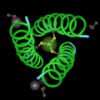The American Society for Human Genetics is sponsoring the second annual DNA Day Essay contest. If you are a high school teacher here's your chance to combine an interesting assignment along with a contest.
This year's essay questions are:
- If you could be a human genetics researcher, what would you study
and why? - In what ways will knowledge of genetics and genomics make changes
to health and health care in the US possible?
The rules are here at GenEdNet.org
I also have an animated tutorial at Geospiza Education that might be of some help. The tutorial is titled Allelic Variants of Human Superoxide Dismutase.
It demonstrates how to find the following types of information:
- Stories about people who have a genetic disease.
- The inheritance pattern of a genetic disease - is it dominant, recessive. etc.
- Use the Gene database at the NCBI to find the gene sequence, mRNA sequence(s), and protein sequence(s).
- Find out where polymorphisms or mutations are located in the gene, using OMIM (the on-line Mendelian Inheritance in Man database).
- See where mutations map in the three dimensional structure of a protein.
- See how to search scientific literature and find freely accessible journal articles.
Check it out and Write away!
Categories
